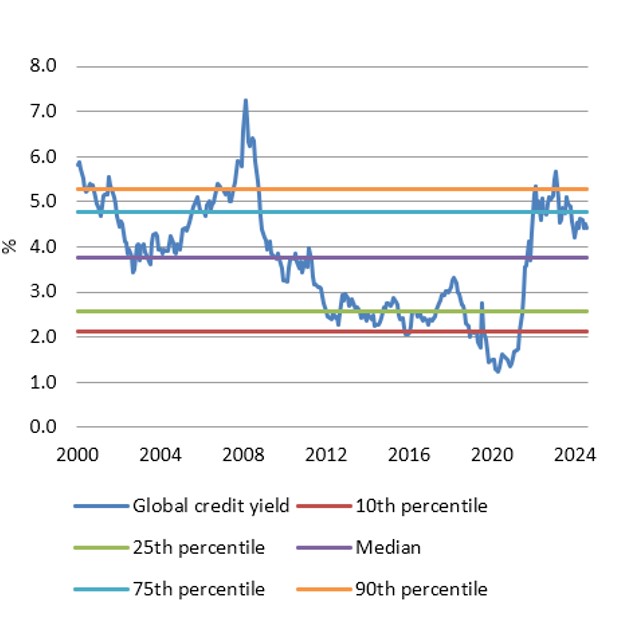Investment Strategies
Compelling Yield Without Compromising Quality

This article examines the credit universe, what it consists of, its place in portfolios and behaviour across time.
The following article from BNY Investments, which examines the world’s credit market, argues that global credit should be a core part of a portfolio. The editors are pleased to share this material; the usual editorial disclaimers apply to views from outside contributors. To comment, email tom.burroughes@wealthbriefing.com and amanda.cheesley@clearviewpublishing.com
At BNY Investments, we believe that global credit is endowed with
a number of favourable qualities, compared with other financial
asset classes. It includes thousands of issuers with good credit
quality, diversity and depth in the investable universe, and
yield with the potential for income streams relative to history.
In our view, these features create a compelling case for
considering a core global credit allocation.
Let’s look at them in turn.
Investment grade at its core, worldwide in its
spread
A global credit universe will typically consist of high-quality
securities, across the investment grade spectrum, from the
highest AAA rating, through to BBB-. The Bloomberg Global Agg
Credit Index (the “Index”) is a common benchmark for global
credit managers and, as of March 2025, contains more than 20,000
securities, from more than 2,600 issuers, demonstrating the
breadth and depth potential opportunities within the market. Its
geographical coverage ranges worldwide rather than being confined
to single discrete markets. It consists of borrowers from around
the developed and developing worlds and in a number of
currencies, with the dollar being dominant.
Corporate issuers and more besides
The bulk of the global credit world is made up of issues from
corporate borrowers, covering the breadth of the economic
landscape. They range from industrial sectors to utilities and
financials. Industrials include sectors such as automotives,
pharmaceuticals, energy, telecoms, and technology, while
financials capture sectors such as banks, insurers, and real
estate investment trusts (REITs). Utilities are typically a
smaller sector covering electricity and gas providers.
However, the credit universe is broader than the corporate
universe as it also includes issues from a collective of
government-related, or non-corporate, entities. In general, they
have stronger average credit ratings than the corporate issues in
the universe and come from four key sources.
Supranational entities, such as the European Investment Bank and
International Bank for Reconstruction and Development, make up
about a tenth of the Index and are mostly highly rated (AAA).
They have maturities across a wide spectrum, having been out more
than 30 years in some cases.
Two further categories are government agencies and local
authorities, such as the Export Import Bank of Korea and the
province of British Columbia in Canada. Last, it includes some
sovereign issues by governments borrowing in a currency other
than their own, with examples such as dollar bonds issued by
Mexico, or euro issues from Poland, or Italy borrowing in
sterling.
Yield levels create an appealing draw for inflows to the
asset class
The level of yield available in the global credit market has
varied greatly over the last 25 years (see Figure 1). Today, they
are at attractive levels relative to the last 15 years or so.
Figure 1: Yields on global credit at attractive levels (1)

In the 2000s, prior to the global financial crisis, the average
yield on of the Index ranged between approximately 4 per cent and
6 per cent. (2) During that period credit spreads over
government bond yields tightened to the narrowest they had been.
Spreads remained tight for most of the period from 2004 to 2007,
with the increase in the overall yield during that time stemming
primarily from higher government bond yields.
The global financial crisis in 2008 to 2009 created a sharp spike
higher in spreads, which took investment grade credit yields to
new highs, briefly exceeding 7 per cent, despite underlying
government bond yields falling at the time. The ensuing economic
decline and the extensive economic and market support measures
that governments and central banks implemented, brought about a
rapid decline in spreads and with that, yields. Though spread
levels remained volatile for much of the next decade, yields
trended lower and lower. Yields fell below 2 per cent just prior
to the Covid-19 pandemic, which may have brought the attractions
of global credit into question, but even then, spread levels did
not appear uncomfortably tight as the alternative, yields on
government bonds and cash deposits were close to or in some
cases, below zero.
Yield levels on credit rose sharply in 2021 and 2022 as inflation
took hold and as central banks sought to combat rising prices by
rapidly increasing official interest rates. In a short space of
time, credit yields rose above 5 per cent for the first time
in more than a decade.
Spread levels have also risen in recent months, pushed higher by
an increase in economic uncertainty to a point that is much
closer to what we see is fair value.
Current attractions of global credit: protection and
potential
Higher yields and spreads appeal in two important ways. First,
higher yield levels can provide some form of protection, with
higher ongoing income insulating investors who may be concerned
about the possibility for future capital losses. Second, the
higher yields are, the greater is the potential for them to
decline and generate capital gains.
Markets are in a position where lower yields could come from two
sources: either underlying government bond yields could decline,
as may occur if inflation concerns continue to ease; or credit
spreads could tighten, which may result if economic concerns
dissipate.
Only recently, investors would likely have had to take on greater
risk in high yield markets to have been able to achieve the
levels of yield that investment grade markets currently offer.
They have seen that as an attractive opportunity. Now that
investment grade markets offer attractive yields alongside lower
risk, we believe that global credit will be attractive for many
investors.
Footnotes
1, Source: Insight and Bloomberg. As at 30 April 2025.
Bloomberg Global Agg Credit Index yield to worst.
2, Source for all yield data: Insight and Bloomberg. As at
30 April 2025
Disclaimer
Investment managers are appointed by BNY Mellon Investment
Management EMEA Limited (BNYMIM EMEA), BNY Mellon Fund Management
(Luxembourg) S.A. (BNY MFML) or affiliated fund operating
companies to undertake portfolio management activities in
relation to contracts for products and services entered into by
clients with BNYMIM EMEA, BNY MFML or the BNY Mellon funds.
The value of investments can fall. Investors may not get back the amount invested. Income from investments may vary and is not guaranteed.
Important information
For professional clients only. This is a financial promotion.
Any views and opinions are those of the investment manager,
unless otherwise noted. This is not investment research or a
research recommendation for regulatory purposes.
